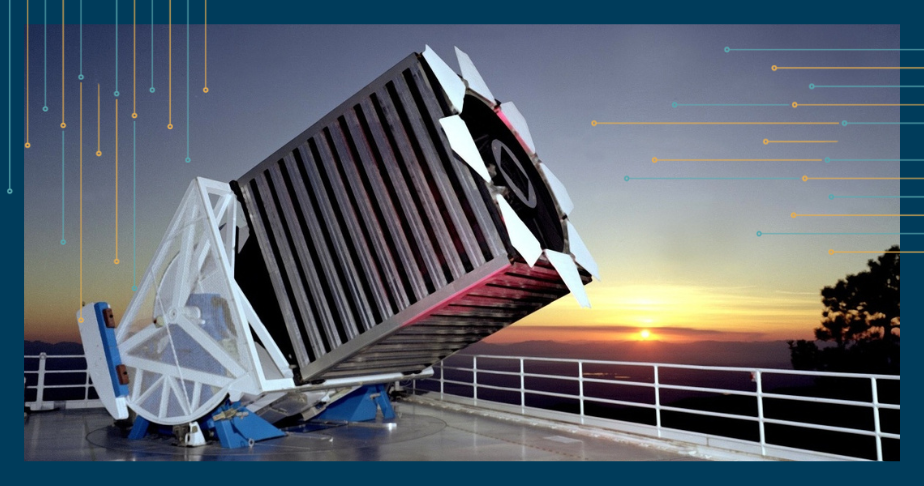
The Sloan Foundation telescope at Apache Point, New Mexico.
Program Goal
To accelerate discoveries in astronomy and astrophysics through the support of an all-sky spectroscopic observation program that uses telescopes in both hemispheres to comprehensively map the night sky, examine the history and structure of the universe, and probe the physics of black holes.
About
The Sloan Digital Sky Survey (SDSS) is one of the largest, most detailed, and most often cited astronomical surveys that has ever existed, with the goal of expanding our understanding of the large-scale evolution and structure of the universe, the formation of stars and galaxies, the history of the Milky Way, the nature of supermassive black holes, and the science behind dark energy. By comprehensively mapping and across over a third of the night sky, SDSS represents one of the major quests of contemporary physics and has spurred advancement on answering a range of fundamental questions about the origins of the universe.
By supporting the Astrophysical Research Consortium for over 25 years, the Sloan Foundation has helped to build and operate the pioneering Sloan Foundation Telescope at Apache Point Observatory in New Mexico and conduct experiments to observe millions of stars, galaxies, quasars, and other cosmological phenomena. The current fifth phase of SDSS, SDSS-V, is led by Director Juna Kollmeier and includes a partnership with the Carnegie Observatories to conduct a full set of observations across both hemispheres with the utilization of the Irénée du Pont Telescope at Las Campanas Observatory in Chile. SDSS-V represents the next major wave of the collaboration’s scientific and technological advancement and innovation, including upgrades to a state-of-the-art robotic observation system.
SDSS remains distinctive within the astronomical community for its participatory, bottom-up scientific research planning process. SDSS-V currently includes over 40 contributing institutional partners who are formal members of this phase of the collaboration, and SDSS-V has received financial support from the National Science Foundation, Heising-Simons Foundation, and the Simons Foundation. SDSS is committed to making advancements with respect to diversity, equity, and inclusion. With support from the Sloan Foundation, SDSS has developed its Faculty and Student Team (FAST) Initiative to involve greater numbers of under-represented students and faculty of color in the collaboration.
All SDSS data is eventually released in full to the entire astronomy community and the broader public under open use principles. In the mostly recently completed fourth phase of SDSS (SDSS-IV), scientists participating in the collaboration have written nearly 1,500 papers using SDSS data, with over 26,000 citations. A total of nearly 10,000 papers with over 500,000 citations have been produced over the course of SDSS’s history when the use of public data releases is included. SDSS is currently the Foundation’s longest running scientific research program.
Structure
Overseen by the Astrophysical Research Consortium, SDSS-V consists of a partnership with the Carnegie Observatories and involves observations in the northern and southern hemispheres. In the northern hemisphere, observations are conducted at the Sloan Foundation Telescope at Apache Point Observatory in New Mexico. In the southern hemisphere, observations are conducted at the Irénée du Pont Telescope at Las Campanas Observatories in Chile. SDSS-V is composed of three sub-surveys.
-
Milky Way Mapper (MWM)
A project to examine the history and evolution of the Milky Way galaxy by studying over 4 million stars by using near-infrared and optical spectroscopy.
Visit Site -
Black Hole Mapper (BHM)
A project to study the history and evolution of over 400,000 supermassive black holes that sit at the heart of most galaxies.
Visit Site -
Local Volume Mapper (LVM)
A project to study the dust and gas that lies within and between galaxies to help improve understanding about how galaxies evolve.
Visit Site
News
See All-
Sloan Digital Sky Survey
The “Barbenheimer Star”: Evidence for Spectacular Nucleosynthesis in the Early Universe
-
Phys.org
Astronomers discover new link between dark matter and clumpiness of the universe
-
Assembly Magazine
Precision Motion Control Helps Map the Universe
-
The New York Times
Courting the Sirens of the Southern Sky
-
Eos
Deluges of Data Are Changing Astronomical Science
-
Vice
Scientists Glimpse Faint Shocks in Cosmic Web that Links the Universe
Resources
-
SDSS Website
The online home of SDSS
Visit Site -
SDSS Science Blog
Recent SDSS news and stories
Visit Site -
SDSS Data Release 13
The most recent public release of SDSS data
Visit Site -
SkyServer
The SDSS data platform
Visit Site -
SDSS Voyages
SDSS data and discoveries for the non-astronomer
Visit site -
Faculty and Student Team (FAST) Initiative
Promoting diversity in the SDSS collaborative
Learn more
Apply
This program does not accept unsolicited letters of inquiry. Scholars interested in participating in the Sloan Digital Sky Survey should contact the SDSS directly.